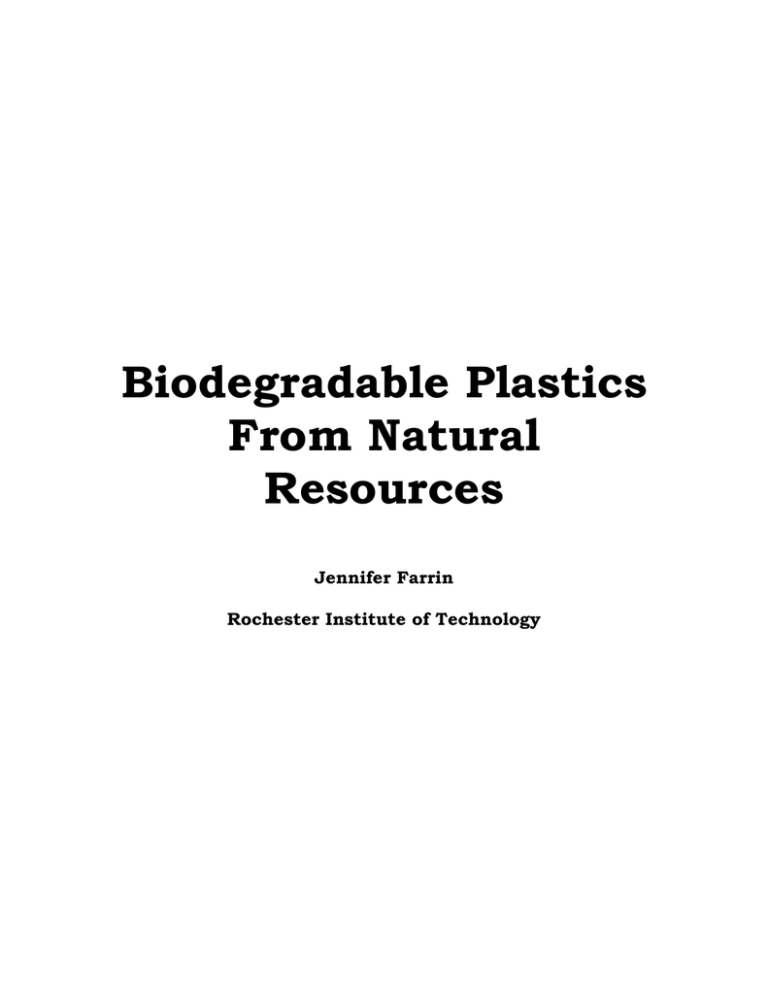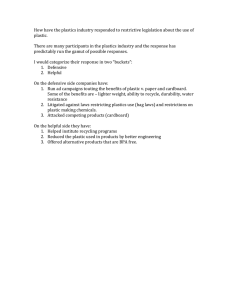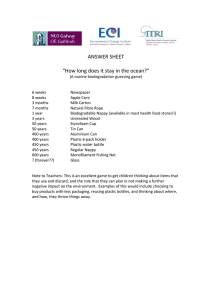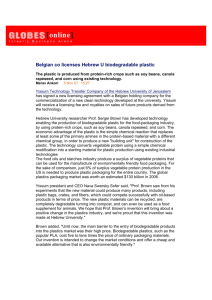Biodegradable Plastics From Natural Resources
advertisement

Biodegradable Plastics From Natural Resources Jennifer Farrin Rochester Institute of Technology 1 Today’s consumer driven society demands plastic for the manufacture of millions of products. Packaging materials largely contribute to the high demand for plastics. Our fast paced lifestyles demand convenience and single serving, pre-packaged foods. The manufacture of cost effective packaging that adequately protects the product is made possible by plastic. Plastic is made from crude oil, a nonrenewable resource. Although the plastic we use can be recycled, the amount of solid waste generated by plastic is becoming a problem. In recent years, natural renewable resources have successfully been used to produce plastic that is biodegradable under certain temperature and humidity conditions. Biodegradable plastic made from renewable resources is an important material innovation because it decreases dependence on petroleum and reduces the amount of waste material, while still yielding a product that provides similar benefits of traditional plastics. Over the last fifty years, the production of plastic has reached enormous levels. Approximately two hundred billion pounds of plastic are produced worldwide every year. This equates to about forty pounds of plastic per person, per year. Between thirty and forty-two percent of plastic produced is used for packaging (Stevens 6). Of the plastic produced, more than sixty billion tons are thrown away every year in the United States. Approximately half of this waste is attributed to packaging (Stevens 16). The oil that is used as a raw material, as well as 2 the oil required for energy, consumes between six and eight percent of the total world oil production. Although this is a small percentage, over time the amount of petroleum used to make plastic does contribute to the depletion of fossil fuels (Stevens 15). The rate of consumption influences the overall price of petroleum, contributing to the current rise in raw material costs. Plastics derived from petroleum are made from synthetic polymers. However, polymer chains are also found in nature. These chains are common in cellulose, lignin, and starch. Cellulose is abundant in all plants, although some plants produce more than others. Lignin is typically found in wood, and starch is common in plants such as corn, potatoes, and wheat. Plants, wood, corn, potatoes, and wheat are all raw materials that are renewable and readily available. The major difference between synthetic polymers and polymers found in nature is that the natural polymers contain oxygen and nitrogen. The oxygen and nitrogen in the polymer structure permit the polymer to biodegrade. Both cornstarch and wood are inexpensive raw materials. At the current rate of production, the need for corn does not compete with the food supply. As production of natural resource polymers increases, there is speculation that the need for corn to make plastic will interfere with the food supply. An advantage of using corn is that because the corn is not directly consumed, waste corn can be used. The raw material does not need to be in pristine condition. Some argue that growing corn has a 3 negative impact on the environment. They claim the impact of additional pesticides, fertilizers, and the cultivation of more land is detrimental enough to outweigh the benefits of biodegradable plastics. This has spurred research into a number of possible alternative materials including waste wood pulp and wood pieces from paper mills. To make plastic from natural sources, the polymers are isolated from the raw material. Depending on the material used, different technologies are required to produce plastic. Typically, the polymers are synthesized using chemicals or by fermenting the sugars. When using corn to produce plastic, the lactic acid is extracted from the corn. Through purification processes, the starches in the corn are broken down into sugars. The sugar is fermented and the carbons in the sugar are removed. The plastic is then created from the carbons in a manner similar to plastic made from petroleum carbons. The first documented interest in producing plastic from renewable resources came from Henry Ford around 1910. Ford was interested in making plastic from agricultural waste. In 1941, he succeeded and produced a “plastic car” from soybean waste mixed with other components to increase strength. Although not a new technology, public enthusiasm for biodegradable polymers did not gain momentum until the 1960s. During this time period, many people felt that too much plastic was being produced and the waste was adversely affecting the environment. New awareness in relation to the human impact on earth 4 gave way to an environmentalist movement that helped push research in the area of plastic. Although not a new idea, the use of biodegradable plastics made from renewable resources for use in packaging has only recently been implemented. Natural polymers do not always possess the characteristics desired in a plastic. It is common for natural polymers to be mixed with petroleum-based polymers to obtain desired characteristics. For example, polymers produced from starch are not very strong and can be mixed with petroleum-based plastics such as polyethylene and polyvinyl alcohol to increase their strength. In the 1980s, these mixtures were marketed as biodegradable plastics (Scott 468). These plastics were quickly accepted by consumers but soon came under harsh scrutiny. These polymers present a problem when composted because the starch easily biodegrades, but the polyethylene and polyvinyl alcohol do not. Labeling these polymers as biodegradable is considered deceptive because the residues of these plastics stay in the compost for many years. Polymers produced entirely from renewable resources degrade completely and are not misleading in their claims. When the plastic degrades, it yields carbon dioxide, nitrogen, water, and other minerals. Because of the disagreement over what constitutes degradation, standards have been developed by associations currently involved in the plastic industry. Key organizations that regulate biodegradable plastics 5 are the International Standards Organization and the American Society for Testing and Materials. Guidelines specify the conditions at which a polymer biodegrades, what constitutes a biodegradable plastic, and the number of additives used in a plastic. Minimum allowances for contaminant levels once the plastic has degraded are outlined and monitored with toxicity tests. These tests determine the impact of any toxic substances on the environment. In order to prove that the polymer is indeed degrading, the weight loss of the polymer mass is measured. In 2002, the production of biodegradable plastics was less than one percent of the production of plastics (Scott 10). One of the more commercially successful plastics is PLA, so named because it is produced from the poly lactic acid found in corn. Poly lactic acid is present in the metabolism of all animals and microorganisms and does not produce toxic byproducts when it biodegrades. A leader in the packaging arena, PLA is currently only produced on a small commercial scale. PLA most closely resembles polyethylene in structure and properties. PLA is a hard, transparent, crystalline plastic. The resin is also clear, stiff, and glossy and has flavor and aroma barrier properties similar to PET (Defosse 32). PLA is an excellent water and grease barrier and performs well as both a rigid and flexible material. PLA can also be used as coating on other materials. Like petroleum based plastics, the physical properties of PLA can be changed with co-polymerization. In addition, PLA can be oriented and biaxially oriented to improve barrier 6 properties. Oriented PLA is stiff and has excellent twist retention and clarity. It provides a great flavor and aroma barrier and has been used to replace cellophane in candy wrappings. A major advantage of PLA is that it is compostable and also recyclable. In some packaging applications, PLA is believed to exceed the performance of petroleum-derived plastics. Polypropylene is typically used in pharmaceutical packaging. PLA was found to protect the product better than polypropylene. Polypropylene can absorb aromatic compounds in the pharmaceuticals and swell the packaging. This problem was not detected when pharmaceuticals were packaged in PLA (Moore 41). Concern has been raised over the ability to process natural resource plastics. In fact, they can be manufactured using similar processes and the same machinery as petroleum based plastics. Natural plastics have been successfully extruded, injection molded, blow molded, fiber spun, and thermoformed (Stevens 128). Another misconception concerning natural polymers is that they cannot be exposed to high temperatures. Although high temperatures will initiate the degradation of the polymer, water must also be present. The combination of temperature and water allows the plastic to degrade. The melting point of PLA is between 175 and 185 degrees Celsius. Products are rarely exposed to such high temperatures, and the plastic is safe for use until those temperatures are reached. Technology has been 7 developed to increase the biodegradation temperature of PLA. The polymer is briefly exposed to gamma irradiation allowing for greater heat resistance. A similar process is currently used and approved by the Food and Drug Administration to extend the shelf life of meat. Biodegradable plastics have also emerged in Europe and Japan. Many products that are packaged in Japan are sold around the world. Japan’s use of natural plastic packaging is a positive indication that this new technology will continue to grow. Eiichi Takeshita, consultant for the Tokyo office of the U.S. Grains Council claims that “the most encouraging thing is that Japanese consumers love the implications of biodegradable plastics'' (Moore 41). The high cost of resin is a major factor slowing the growth of biodegradable plastics in Japan. Other exciting uses for natural polymers have also emerged. The JPS Corporation in Tokyo produced foam packaging using a biodegradable polymer. The foam packaging is similar to starch packaging material. The material is known as ‘green block’ and was designed to replace polystyrene, expanded polypropylene, and expanded polyethylene (Moore 41). Biodegradable polymers are safe to use in food packaging. Several food companies have successfully used biodegradable plastics from renewable resources in their packaging. These companies see packaging as part of the product and claim that using more environmentally 8 friendly packaging coincides with their corporate philosophies and commitments to quality food (Butschli). Cadbury Schweppes currently makes thermoformed plastic trays that hold their line of milk tray deluxe selection chocolates from a biodegradable plastic. This plastic is supplied by Plantic Technologies and is water-soluble. The plastic is made from cornstarch that does not come from genetically modified corn. The company clams the trays will biodegrade in almost any environment, including compost bins or at home worm farms. This innovative technology was developed after seven years of research by the Cooperative Research Center for International Food Manufacture and Packaging. The candy boxes are printed with text that informs the consumer of the environmentally friendly packaging inside (Butschli). Biorigin, an Italian company that makes organic pasta, packages its fresh pasta in containers made from Natureworks PLA plastic. This is a clear plastic produced by Cargill Dow. Cargill Dow, as well as other Italian manufacturers will supply Biorigin with this plastic. The plastic used by Biorigin is also made from corn. The plastic trays are covered with a plastic film made from Natureworks PLA. The film is heat sealed to the tray. Another Italian Company, ISAP produces an egg tray and trays for fresh fruits and vegetables from Natureworks PLA. The IPER chain uses Natureworks PLA to package tomatoes, ham, sliced salami, and cheese (Butschli). 9 In the United States, Wild Oats Markets are replacing its deli containers with Natureworks PLA. The company has plans to increase the number of products packaged in this new plastic. The senior vice president of operations from Wild Oats claims that the containers made from Natureworks PLA actually function better than their previous containers. The new Natureworks PLA containers have greater strength, clarity, and better contain the flavor and the aroma of the products (Butschli). Extruded roll stock used for thermoforming is currently produced by ExTech Plastics in Virginia. The vice president of sales at ExTech is pleased with the roll stock made from Natureworks PLA and claims the plastic has “good strength and outstanding gloss and clarity…with characteristics similar to PET.” The thermoformed containers do not lack detail and have the same level of performance as non-biodegradable plastics (Butschli). Compostable plastic is not without its disadvantages. A major disadvantage of natural plastic is how to facilitate biodegradation. Because this technology is so new, waste management facilities are not equipped to compost the plastic. The burden of collecting and composting the plastic falls to whoever sells the plastic to the consumer. Wild Oats Markets sells several products packaged in biodegradable plastic made from corn. The plastic containers purchased at Wild Oats can be returned to the store. The store then sells them to a vendor who 10 composts them into plant food. Wild Oats Markets has implemented a unique closed loop system where the plant food produced by the vendor is then sold in the Wild Oats stores. It is important that plastic made from natural resources is composted and does not become solid waste. Packaging products with biodegradable plastic is more expensive than traditional petroleum based plastic. The resin costs for this plastic are high because it is a new technology used by only a few companies and supported by an even smaller number of suppliers. The additional cost of packaging products is not justifiable unless the packages are prevented from entering the waste stream and are composted instead. A characteristic of successful innovation is when a technology can be incorporated into many areas. Biodegradable plastic has been successful in many applications. Many farmers use blankets of biodegradable plastic made from petroleum to cover their fields and increase their product yield. Biodegradable plastic produced from natural resources degrade completely, while current polymers leave residues. The medical industry uses large amounts of one-time use products every day. Plastic gloves and other hygienic products are not recycled and are thrown into landfills. In the United States, there is a growing interest in using biodegradable plastics for compost bags. These bags would replace paper and plastic bags. Not only would the yard waste inside the bag be biodegradable, but the bag would also degrade. 11 In conclusion, there is a limited amount of petroleum available for human consumption. As oil prices rise, more consideration is given to replacing oil-derived polymers with polymers produced from renewable resources. We must implement the use of an alternate raw material given the range of applications for which plastics are used. Alternative methods of generating power such as solar, hydrogen and wind power are heavily researched. The decision to produce plastic from renewable resources follows the current shift away from the use of fossil fuels. A choice does not need to be made between the benefits plastics provide and the impact on the environment. Biodegradable plastics made from renewable resources can retain all the benefits of petroleum based plastic without the negative environmental impacts. The discovery and implementation of plastic made from natural resources is a gigantic leap into the future for the packaging industry. 12 Works Cited Butschli, Jim, ed. “Packagers embrace renewable resources.” Packaging World Magazine Feb. 2004. 3 Jan. 2005 <http://www.packworld.com/cds_search.html?rec_id=17260&ppr_ key=PLA&sky_key=PLA&term=PLA>. Carraher, Charles E. Jr. and L.H. Sperling, eds. Polymer Applications of Renewable-Resource Materials. New York: Plenum Press, 1983. Carraher, Charles E. Jr. and L.H. Sperling, eds. Renewable-Resource Materials New Polymer Sources. New York: Plenum Press, 1986. Ching, C., D. Kaplan and E. Thomas, eds. Biodegradable Polymers and Packaging. Lancaster, PA: Technomic Publishing Company, Inc., 1993. Defosse, Matthew. "Biodegradable resins gather momentum for mainstream use. " Modern Plastics 76.1 (1999): 32. Rochester Institute of Technology. 18 Feb. 2005. ABI/INFORM Global. ProQuest. <http://proquest.umi.com/pqdweb?did= 38860594&Fmt=3&clientId=3589&RQT=309&VName=PQD>. Moore, Stephen. "Laws create new potential for biodegradable use in Japan. " Modern Plastics 76.5 (1999): 41. Rochester Institute of Technology. 18 Feb. 2005. ABI/INFORM Global. ProQuest. <http://proquest.umi.com/pqdweb?did=42652159&Fmt=3&clientI d=3589&RQT=309&VName=PQD>. Scott, Gerald, ed. Degradable Polymers Principles and Applications. 2nd ed. Boston: Kluwer Academic Publishers, 2002. Stevens, E.S. Green Plastics: An Introduction to the New Science of Biodegradable Plastics. Princeton, NJ: Princeton University Press, 2002.








